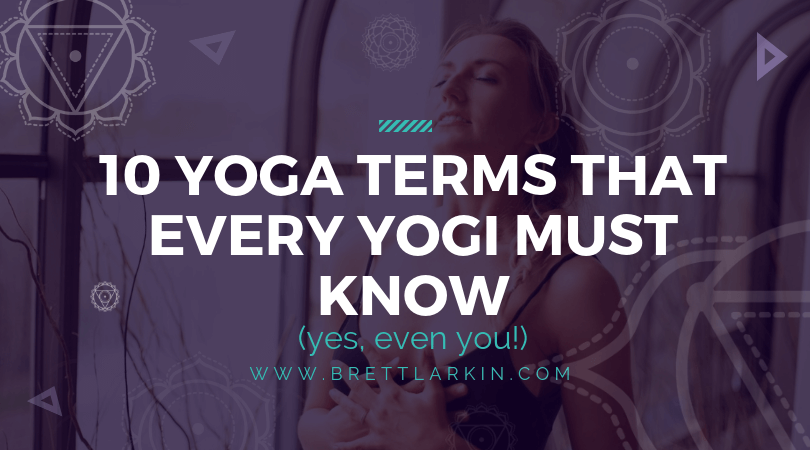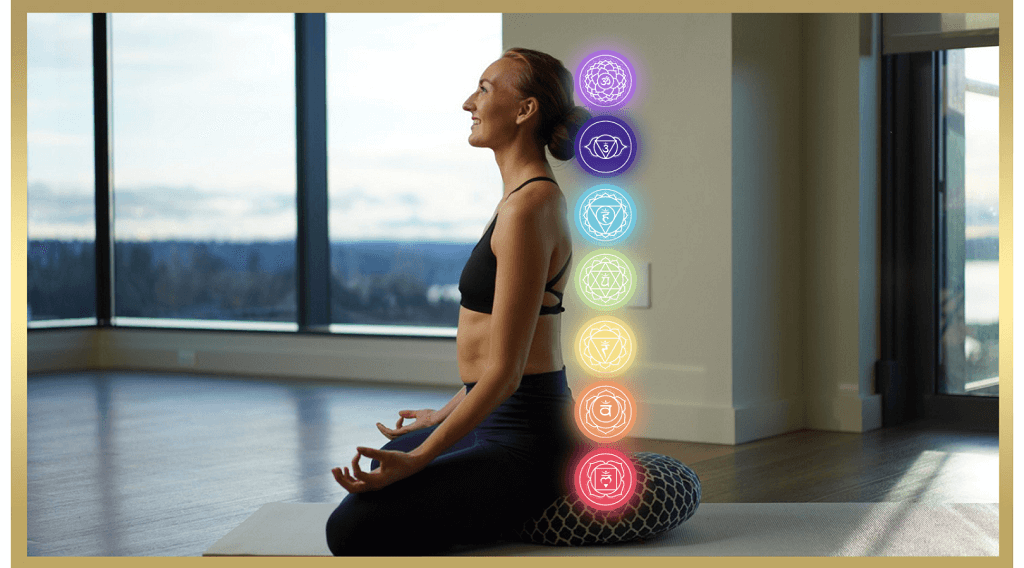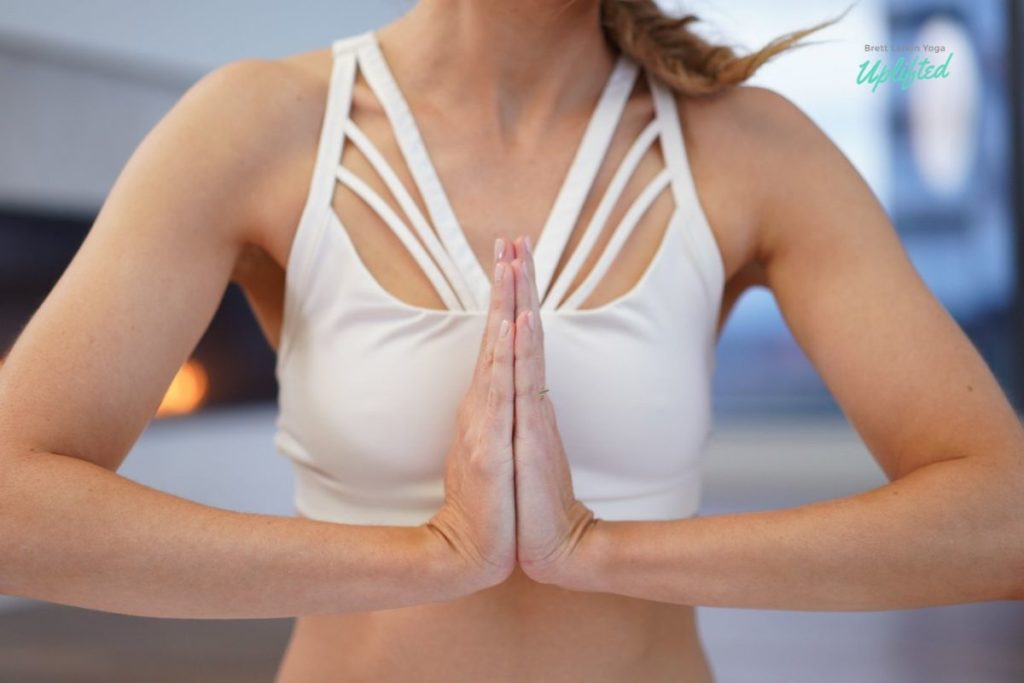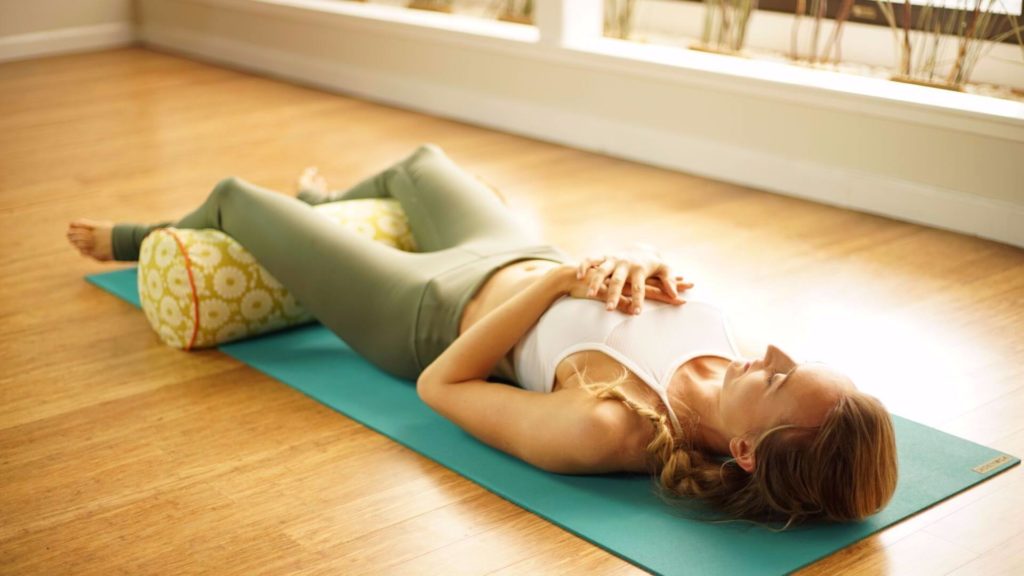
Imagine this. You are blissfully flowing through a yoga class when suddenly the instructor says something in Sanskrit. As much as you try to stay present, you can help but think, “what did they just say?” “what do they want me to do?”
When you first hear these words it can be confusing or distracting. Neither of those are things we want during yoga class.
We’ve all been there though. In the beginning, yoga class can feel like everyone is speaking a secret language. In a way this is true. The secret language is Sanskrit.
Where Did These Yoga Words Come From?
Yoga is more than postures, it’s a spiritual discipline. It was passed down through ancient texts called sutras. Sutras can be compared to other ancient texts like the Bible or the Quran.
There are a few different ancient texts that talk about yoga. The Upandishads was one of the first scriptures to mention it. Later, a sage Patanjali wrote the Yoga Sutras. This text gave a more defined system of yoga. This system is also referred to as the eight limbs of yoga.
All the yoga texts were originally written in Sanskrit. So, the words you hear in class are coming straight from ancient yoga texts. Pretty cool, isn’t it?
Sanskrit doesn’t have to be intimidating though. In fact after you learn a few basic meanings, other words will start to make sense too. A quick crash course in yoga lingo can actually help you deepen your practice. Plus, you won’t feel so lost in your next yoga session at your local yoga studio.
10 Most Common Yoga Terms Used in Class
The yoga instructor will often call out the Sanskrit names of the postures (even though they don’t always pronounce them correctly!). We won’t go into all of those here. Let’s just focus on some common yoga terms that you’re likely to hear in class.
1. Asana
Let’s go back to the eight limbs of yoga that we mentioned. Think of these as different steps towards enlightenment. One of these steps is asana.
Yoga asanas, which loosely translate to yoga postures, are some of the most popular yoga terms in the west, though they comprise of only one part of the eightfold path as outlined by yoga of Patanjali.
In the yoga sutras, asana is explained as ‘that position which is comfortable and steady’. There are different paths in yoga, two of which use asana as part of the practice. Let’s take a look at those.
Raj yoga is the path of meditation and contemplation. In this path of yoga, the goal is stillness. The asanas in this path will all be seated and meditative. Hatha yoga is the path that we all know. It’s the path of physical postures.
The original yogic texts listed over 8 million asanas in hatha yoga. Lucky for us they’ve narrowed it down to a much more manageable 84. The asanas are meant to open different energy channels in the body.
So how does that sound in your Ashtanga yoga or Vinyasa flow yoga class? You’ll hear your yoga teacher call out downward facing dog, cobra pose, mountain pose, or basically any other pose, and it’s just an English translation of the different yoga postures/asanas of Raja yoga.
2. Chakra
The word chakra literally means ‘wheel’ or ‘circle’. In the context of yoga though, it’s a little different. A better description would be ‘vortex’.
This vortex is actually an energy center, also called a chakra. Our chakras are the areas where different energy pathways come together.
We have one main energy channel, called sushumna, which runs along our spine. This is why all of our chakras are located along the spine. There are seven chakras in the body. They begin at the tailbone and go up the third eye point.

Yoga is really meant to help prana, or life force energy, move along our energetic body via the chakras. So yoga postures, mantras, meditation, and pranayama breathing techniques are all meant to support this energetic movement along the chakra system.
3. Drishti
You may have heard in a class, ‘focus your drishti’’, meaning your gaze. Focusing your gaze on certain points can have a calming effect on your mind. It can be helpful in meditation as well.
4. Bandha
The Sanskrit term bandha means to ‘hold’, ‘tighten’ or ‘lock’. The translation just happens to describe why and how we do this practice. Bandhas are used to control the flow of energy, or prana, through your body.
There are three bandhas in the body, Jalandhara bandha, uddiyana bandha and moola bandha. They are situated respectively in the throat, abdomen and perineum.
The one you’ll hear mentioned most often is moola bandha, or the ‘root lock’. To activate this bandha, contract the muscles in your pelvic floor. You may practice moola bandha as part of a meditation or pranayama practice.
What is pranayama you ask?
5. Pranayama
Pranayama breathing is one of the most important aspects of yoga. Maybe even more than the physical postures. Along with asana, it’s one of the eight limbs of yoga.
The term pranayama is actually two Sanskrit words together. Prana means ‘life force’ or ‘vital energy’. Think of prana on two levels. On the spiritual level it is our life force. On the physical level, prana is our breath.
The second word, ayama means expansion. So, pranayama is the practice of expanding your energy. This might sound intimidating, but it’s as simple as breath control.
Ujjayi breath is one commonly used pranayama. It helps to regulate the body temperature and brings a meditative quality to your practice. Ujjayi is especially helpful during a more physical class.
This breath is done by restricting the back of the throat. I like to think of it as the Darth Vader breath because that’s the sound you’re going for. Your inhales and exhales should be audible. Aim for long and deep breaths.
6. Mudra
Mudras, or gestures, are done to deepen awareness and concentration. They can involve the whole body, or be as simple as a hand gesture. There are grouped into categories based on which part of the body is used.
Remember bandha (#4)? Well, it’s actually a type of mudra. It’s pretty important though, so it’s usually considered a practice on its own.
The other group you’re likely to see in class are the hand mudras. Jnana mudra is the most common. To do this mudra, bring your thumb and forefinger together. Leave the other three fingers out straight.
Jnana mudra is used in meditation because it’s known as the gesture of knowledge.
7. Mantra
Mantras are words or phrases that are repeated. They actually work in two ways. First, in the meaning of the words that are being said. Second is the repetition of the words. This gives the mind something to focus on.
A yoga class may begin or end with a mantra. Sometimes a teacher will have you create your own. Don’t let this intimidate you. It can be simple. Just think of where you want to focus your mind.
Some mantras I like to use are, “I am strong” or “I am exactly where I’m meant to be.”
8. Om
This one is tricky because there’s no translation for it. It’s actually not a word, it’s a sound. A sound that is made up of three separate sounds, ‘aah’ ‘ooo’ and ‘mm’.
You’ll most likely hear om chanted in the beginning or end of a yoga class. When you chant, focus fully on each syllable, the ‘aah’, ‘ooo’ and ‘mm’. Feel the vibration that the sound makes in your body.
Chant om 3-5 times. Keep your focus on both the sound and the vibration. This simple chant is a good way to end a practice or settle into meditation.
9. Namaste
Namaste is a common greeting in yoga. You’ve probably seen it printed on everything from tote bags to T-shirts too. Some might even argue that it’s overused. What does it actually mean though?
Namaste directly translates to ‘the light in me bows to the light in you.’ It’s said to send peaceful energy out to someone or something. The ‘light’ that’s referred to is the same in all of us. So, namaste can also be a reminder that we are all one.
Whether or not you think it’s overused, it’s still the perfect way to end a yoga practice.
10. Savasana
It’s in every single yoga class. You heard it before, that glorious word savasana. It’s the end of class where we get to lie down and relax.
Savasana is one of the asanas that we talked about earlier. The word translates to ‘corpse pose’ and it’s done at the end of every yoga practice. It might look like nothing, but savasana is actually a beneficial pose.
Relaxing in savasana is what resets our nervous system after a physical practice. It can also prepare the body for meditation.
You Might Also Like: The Complete Glossary of Sanskrit Words Used in Yoga
Final thoughts…
You don’t need to study Sanskrit, but learning just a few words is helpful. You can get more out of your practice and won’t feel lost in class anymore. The secret language won’t be so secret anymore. If you’d like to get started on your yoga practice from home, then check out the free yoga calendar with daily yoga routines that I’ve created just for you! And if you’d really like to take your yoga practice to the next level, then take a peek at my online yoga teacher training program.
And as always, let me know if you have any questions 🙂
Next Steps
- If you’re interested in practical kriya yoga as a way to improve your daily life and relationships, check out my Yoga for Self Mastery course.
- Order my Yoga Life book for a practical guide to creating balance in your life through yoga.
- Check out my YouTube channel and find some yoga classes that you can try out for yourself!
Experience 3 Training Videos from Inside My 200-Hour Online YTT

YOU MIGHT ALSO LIKE
- What is Kriya Yoga? The Philosophy and Practice
- Uddiyana Bandha: Tapping Into Your Deep Core
- 4 Reasons Hasta Bandha Is Essential To Your Yoga Practice
- Vitarka Mudra: What It Is and How Do You Use It?
- Shakti Mudra: What It Is and How Do You Do It?
- Garuda Mudra: What It Is and How Do You Use It?
- Kali Mudra: What It Is and How Do You Do It?
- Shunya Mudra: What It Is and How Do You Do It?
- Varuna Mudra: What It Is and How Do You Use It?
- Vayu Mudra: What It Is and How Do You Use It?
- Samana Vayu: The Energy of Balance & How to Access It
- Apana Vayu: The Energy of Release & Surrender
- Udana Vayu: The Ascending Wind
- Prana Vayu: The Breath of Vitality
- Vyana Vayu: The Energetic Secret to Flow
- Saucha: 6 Ways Purify Your Body, Mind, Relationships & Space
- Aparigraha: 6 Ways To Completely Let Go In Yoga
- Brahmacharya: Yoga’s Guide To Sensual Indulgence
- Tapas In Yoga: 4 Ways This Niyama Will Light Up Your Life
- How To Practice Satya: Ask Yourself These 3 Simple Questions
- What is Mula Bandha and How to Practice It
- The Meaning of Anjali Mudra: Yoga’s Sacred Greeting
- Jalandhara Bandha: 4 Reasons Yogis of All Levels Should Practice It
- Pada Bandha: Your #1 Secret to Happy Feet
- Beyond Corpse Pose: 13 Questions About Restorative Yoga, Answered
- What is Asteya? 5 Powerful Ways to Practice Non-Stealing in Yoga and Life
- Understand the Koshas and Discover 5 Deeper Dimensions of You
- 4 Modern Ways to Deepen Your Svadhyaya (Self Study) Practice
- What are Patanjali’s Yoga Sutras?
- Why Ahimsa (Non-Violence) Improves All Areas of Your Life
- What Is Santosha? Yoga’s Philosophy of Happiness.
- Ishvara Pranidhana: How to Surrender to the Universe
- What Are Nadis? Your Guide to Energy Channels In Your Body.
- The Complete Glossary of Sanskrit Words Used in Yoga
- Where Did Yoga Originate: A Brief History of Yoga
Learn how to do 11 of the most popular yoga poses correctly. Free video + PDF download.













